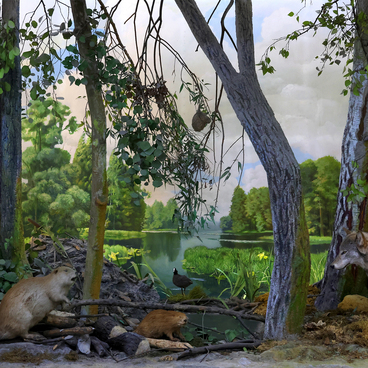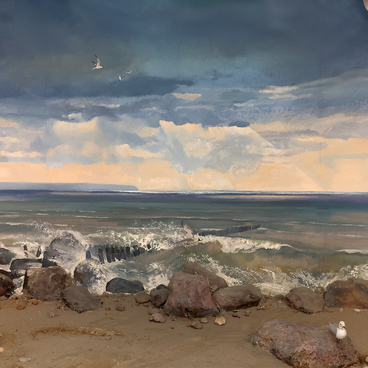This museum diorama shows the natural habitat of the bay and reed thickets. In the Kaliningrad region, the Curonian Bay is the central ecosystem of a large natural complex, which includes the Curonian Spit, the lands of the southern and eastern shores, the estuary of the Neman River, which originates in Belarus.
The Curonian Bay is the largest lagoon in the Baltic Sea basin. The coastline is over 600 kilometers long and the area is 1,584 square kilometers. The average depth in the bay is just under 4 meters, and the water level is generally 12 centimeters above sea level.
This bay in the Kaliningrad Oblast is characterized by high biological productivity. It is rich in commercial fish species, ichthyofauna is represented by bream, pikeperch, smelt, eel, roach, perch and pike. High productivity provides food for hundreds of thousands of birds that annually pass through here during seasonal migrations.
Large colonies of fish-eating birds such as gray herons and cormorants can be found along the shores of the bay, while the eastern coast is home to white-tailed eagles. The gray heron stays close to places with abundant water. It needs extensive marshes, rivers with a wide floodplain, lakes and reed beds. The heron’s dependence on water is mainly explained by the nature of its diet. The main food is small fish and frogs. One of the rare birds of the region, which can be seen near the bay, is the osprey. Its diet consists almost entirely of fish. It hunts on the wing.
The “Curonian Bay”
diorama is actually a vertical section of its aquatic ecosystem. It shows the
water column, muddy ground turning into sandy ground with a significant
admixture of shells. As in nature, species of soft aquatic vegetation are
attached to the muddy soil. Such plants are suitable substrate for bream to
clutch eggs. These fish can be seen on the diorama. Washed out roots of coastal
vegetation and trees are located on the left side of the diorama. In addition
to fish, underwater inhabitants include mollusks and river crayfish — stuffed
animals and models.


